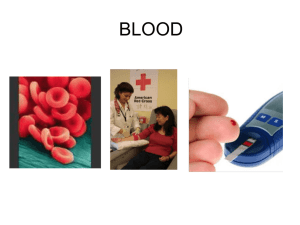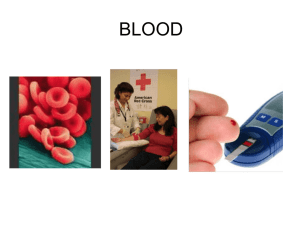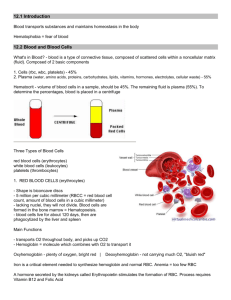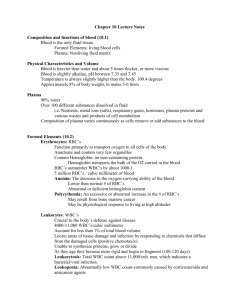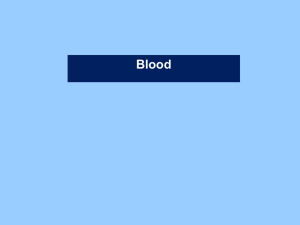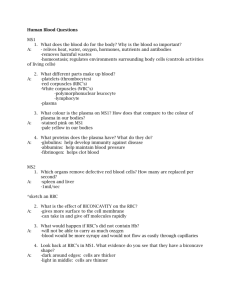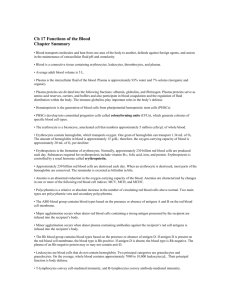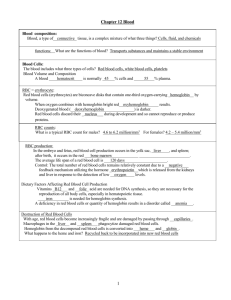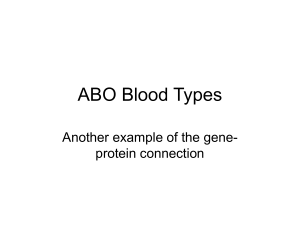Chapter 10 Blood
advertisement
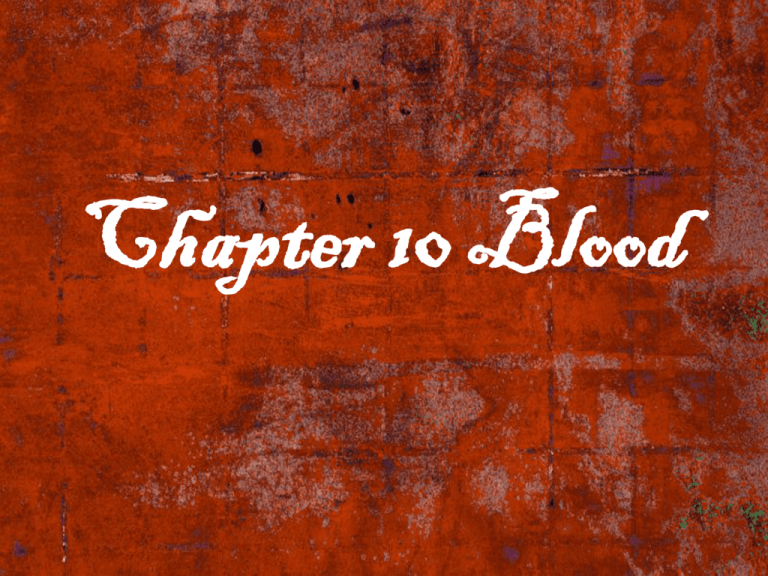
Chapter 10 Blood Functions of Blood • Transport waste and nutrients • Fight diseases • Maintain body temperature • Maintain homeostasis Components of Blood • There are four major components of blood tissue: • Blood plasma: about 55% of blood volume • Red blood cells (erythrocytes): about 45% of blood volume – called the hematocrit • White blood cells (leukocytes) • Platelets Components of Blood Buffy Coat Components of Blood • Fun Facts: 1. has a salty/metallic taste 2. has a pH of 7.35 to 7.45, making it slightly basic or alkaline 3. has a temperature of 100.4°F or 38°C 4. 8% of body weight 5. 5 – 6 liters (6 quarts) in healthy males Components of Blood: Plasma • Plasma: the nonliving, liquid part of blood • About 90% water • Over 100 types of substances are dissolved in the plasma, like… • Proteins, carbohydrates, salts, oxygen, carbon dioxide, hormones, urea, cholesterol, ect. • Functions include: transport everything & maintain body temperature Components of Blood: Plasma • Plasma proteins make the greatest percent of solutes in plasma. • Plasma protein fun facts: – Most are made in the liver with the exception of antibodies and amino acid based hormones – Examples include: antibodies, protein hormones, clotting proteins, albumin – Not assimilated into cells for metabolism Components of Blood: Erythrocytes • Erythrocytes, aka red blood cells aka RBC • Function to transport molecular oxygen to cells for respiration (aka energy production). • They have no nucleus and are merely a hemoglobin sac • Hemoglobin=protein carrier of oxygen and carbon dioxide • 1000 to 1 rbc to wbc count • 1 rbc x 250 million hemoglobin molecules x 4 oxygen molecules = 1 billion oxygen molecules/rbc Components of Blood: Erythrocytes • Homeostatic imbalance: anemia • A decrease in the oxygen-carrying capacity of blood • 1. RBC count too low • 2. hemoglobin amounts too low • See table 10.1, page 311 • Polycythemia: too many rbcs, usually from bone marrow cancer (or living at high altitudes) – impairs circulation due to high viscocity Components of Blood Components of Blood: Leukocytes • Leukocytes, aka white blood cells, aka WBC • Function: annihilation of foreign material • 4,000 – 11,000 per mm3, less than 1% blood volume • The only true cells in blood tissue • Unlike RBCs, these guys can pass in and out of the blood stream as issued by chemical signals (chemotaxis) • Move like ameboas (cytoplasmic streaming) Components of Blood: Leukocytes • Homeostatic imbalances • Leukocytosis: too many WBC; usually an indication of infection; above 11,000 cells/mm3 • Leukopenia: abnormally low WBC count; usually a side effect from certain medications like anticancer treatments or corticosteroids. • Leukemia (“white blood”): bone marrow cancer which produces great numbers of abnormal and immature WBCs. This decreases immune responses and causes death from secondary infection. Components of Blood: Leukocytes Classes of WBC: 1. Granulocytes: have granules that appear with Wright’s stain. a. neutrophils: avid phagocytes (cell eaters) at sites of acute infection. (acute= fast, but short lived) (chronic= long term or recurring) b. Eosinophils: allergy & parasitic worm fighters! c. Basophils: rarest wbc; contain histamines which are chemicals that make blood vessels “leaky” (inflamed) and attractive to other wbc. Components of Blood: Leukocytes Classes of WBC: 2. Agranulocytes: no visible granules when stained. a. lymphocytes: created and reside in lymphatic tissue; produce antibodies; fight tumors, viruses, and grafts. b. monocytes: largest WBCs; they are mutant teenage ninja cells that change into macrophages with voracious appetites; longterm clean up crew for chronic illnesses. Components of Blood: Leukocytes Components of Blood: Platelets • Platelets aka megakaryocyte fragments • Function: to help clot blood • Not cells, but cell fragments • 300,000/mm3 of blood Hematopoiesis • Hematopoiesis: blood cell formation & maturation. • Takes place in red marrow of flat bones and epiphyses of long bones. • Form from the same type of cell called stem cells, or HEMOCYTOBLASTS. • All the cells start out as the same cell, but can become many different kinds of cells. • Once they start down one path, they cannot go back! Hematopoiesis Hematopoiesis Erythrocyte Development • Hemocytoblast stem cell myeloid stem cell immature RBC (with organelles) massive amounts of mitosis and hemoglobin synthesis organelle rejection by the cell and implosion teenaged RBC (reticulocyte-still has ER) to blood stream in two days changes to a mature RBC (no ER) fall apart in 100 – 120 go to spleen, liver for digestion. Hematopoiesis • Hormones control the rate of erythrocyte production. • Erythropoietin – produced mainly by the kidneys; follows negative feedback mechanisms • Low oxygen blood volumes stimulate erythropoietin production in kidneys which stimulates RBC production in bone marrow until oxygen levels rise. Hematopoiesis • Leukocyte production is also controlled by hormones. • Colony stimulating factors and interleukins are stimulated by inflammatory chemicals, bacteria or toxins which stimulate the red marrow to produce more WBC until the situation has repaired itself. • Platelets are regulated by thrombopoietin. Hemostasis: blood clot formation • Step 1 platelet plug formation: when collagen fibers of endothelium are exposed from damage, platelets can stick to them then they call for more until a plug is formed. • Step 2 vascular spasms: platelets in the plug release serotonin which causes blood vessels to contract lowering blood volume. • Step 3 coagulation… Hemostasis: blood clot formation • Step 3 coagulation: a series of hormones and proteins released by the injured tissue and platelets race to the injury, form a fibrous net, close off blood vessels and form a clot! Bam! • See p 316 for more complex version of this story. Hemostasis: Gone Wrong! • 1. undesirable clotting: – Thrombus: clot in an unaffected vessel. Can be caused by…rough endothelium, a physical blow, accumulation of cholesterol, poor circulation. (cardiac thrombosis) – Embolus: a runaway thrombus (cerebral embolus) Hemostasis: Gone Wrong! • 2. bleeding disorders: – thrombocytopenia: causes spontaneous internal bleeding (petechiae); caused by myeloid stem cell suppression (too few platelets) or liver damage (no clotting factor synthesis). – Hemophilia: genetic disease where clotting factors are not synthesized; free bleeding, joint damage and disease from blood transfusions are all symptoms. Blood Groups Blood Groups • Antigen: protein that is recognized as a foreign body; is on RBC cell membranes, bacteria and virus surfaces. Typically we recognize and don’t attack our own antigens. • Antibodies: chemicals in the blood plasma that recognize and bind to foreign antigens. Blood Groups • Agglutination: clumping process caused by antibodies binding to foreign RBCs. • Leads to: clotted blood, ruptured RBCs, loss of oxygen, kidney failure. • Side effects include: fever, chills,, nausea, vomiting • 30 common RBC antigens, but only ABO and Rh give vigorous reactions. Blood Groups Blood Groups Blood Groups • • • • Rh Blood Groups Rh positve = have the Rh antigen* Rh negative = don’t have the Rh antigen Antibodies are formed after first blood transfusion. Then the cells will rupture. • Pregnancy and Rh-: first child will be born fine, then antibodies form in the mother that will affect subsequent Rh+ children. Blood Groups
